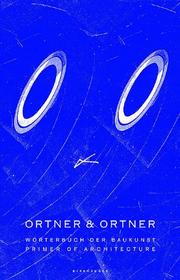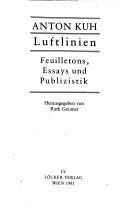| Listing 1 - 9 of 9 |
Sort by
|
Book
Year: 1994 Publisher: Berlin Aedes Galerie für Architektur und Raum
Abstract | Keywords | Export | Availability | Bookmark
 Loading...
Loading...Choose an application
- Reference Manager
- EndNote
- RefWorks (Direct export to RefWorks)
Architecture --- Ortner & Ortner Baukunst [Berlin] --- architecture [discipline] --- Germany
Book
Year: 1976 Publisher: Düsseldorf [publisher not identified]
Abstract | Keywords | Export | Availability | Bookmark
 Loading...
Loading...Choose an application
- Reference Manager
- EndNote
- RefWorks (Direct export to RefWorks)
Book
ISBN: 3925376097 Year: 1987 Publisher: Darmstadt Verlag der Georg Büchner Buchhandlung
Abstract | Keywords | Export | Availability | Bookmark
 Loading...
Loading...Choose an application
- Reference Manager
- EndNote
- RefWorks (Direct export to RefWorks)
7.038 --- 7.07 --- 72.038 --- 72.07 --- Architectuur ; 1986 ; Haus-Rücker-Co ; Lineares Haus --- Architectuur en natuur --- Architectuur ; verplaatsbare ; mobiele --- Kunst en architectuur ; installaties --- Kunstgeschiedenis ; 1950 - 2000 --- Kunstenaars met verschillende disciplines, niet traditioneel klasseerbare, conceptuele kunstenaars A - Z --- Architectuurgeschiedenis ; 1950 - 2000 --- Architecten. Stedenbouwkundigen A - Z --- Haus-Rucker-Co. --- Architecture --- architecture [discipline] --- land art --- installatiekunst --- architectuur
Book
ISBN: 396098555X 9783960985556 9783960985556 396098555X Year: 2019 Publisher: Cologne: Walther König,
Abstract | Keywords | Export | Availability | Bookmark
 Loading...
Loading...Choose an application
- Reference Manager
- EndNote
- RefWorks (Direct export to RefWorks)
Groupe radical emblématique de la scène viennoise des années 1960 et 1970, Haus-Rucker-Co se concentre dès ses débuts sur l’expérience du corps, développant des espaces cognitifs et sensibles qu’ils pratiquent lors de performances dans l’espace urbain. Ces événements doivent stimuler et libérer la conscience, permettant à l’esprit de s’ouvrir à une autre dimension. Après Pneumocosm en 1967, Laurids Ortner et son équipe créent le Mind Expander I (« Extenseur d’esprit »), véritable « instrument pour percevoir le monde interne ». En 1969, le groupe imagine un environnement totalement artificiel, doté d’un équipement électronique, un « Divan d’amour » gonflable, muni d’un casque et destiné à deux personnes, qui permet d’atteindre un état d’extase psychique au moyen de stimuli électro-tactiles. À Vienne en 1970, au Musée du XXe siècle, ils présentent leur Riesenbillard (« billard géant »), un énorme environnement pneumatique pour 100 personnes, qu’ils installeront plus tard au milieu d’une rue de New York. Leur critique de la notion de progrès, de l’industrialisation et de ses conséquences sur l’environnement devient plus virulente au début des années 1970. Ils imaginent alors des projets d’exposition comme Cover : Shell around Haus Lange Museum (1971). Une structure gonflable enveloppe la maison de Mies van der Rohe à Krefeld afin de la préserver de la pollution ambiante. Oase nr.7, une cellule gonflable accrochée à la façade du bâtiment de la documenta V en 1972, reste une image iconique de ce rapport critique et spectaculaire à la ville, toujours à la recherche de nouveaux modes d’habiter. En 1967, Haus-Rucker-Co est fondé à Vienne par de jeunes architectes et artistes, Laurids Ortner (1941), Günter Zamp Kelp (1941) et Klaus Pinter (1940). En 1970-71, rejoint par Manfred Ortner (1943), Haus-Rucker-Co ouvre des ateliers à Düsseldorf et New York, qui deviendront indépendants l’année suivante (Haus-Rucker-Co et Haus-Rucker Inc.). Après la séparation de Haus-Rucker-Inc en 1977, Klaus Pinter débute une activité d’artiste et Caroll Michels une activité d’écrivain. En 1987, des agences indépendantes sont créées par Laurids Ortner, Manfred Ortner à Vienne et Günter Zamp Kelp à Düsseldorf. La dissolution de Haus-Rucker-Co est prononcée officiellement en 1992 à Düsseldorf. The groundbreaking work of the Atelier Haus-Rucker-Co with titles like Ballon für zwei / Grüne Lunge / Sauerstoffquelle / Eingewobene Natur attracted much attention in the 1970s and 80s. The Oase at the legendary documenta 5, 1972, and the frame above the Karlsaue, 1976, were the most photographed works in Kassel. The increasing mobility and the space flight with its space capsules, space suits and the stay in space made the architecture made of stone, which was designed for eternity values, appear outdated in their eyes. The radically groundbreaking "inventions" of the team of artists and architects took place on paper. In excellent, mostly coloured drawings, collages and enchanting models they simulated architectural, avant-garde art spaces, life situations of the future, architecture as a mixture of technology and nature, pneumatic buildings, innovative objects and possible solutions to the topic of environmental pollution. This edition presents almost the complete archive of Haus-Rucker-Co, which is still not accessible today. It provides access to an important and extremely stimulating source on the history of contemporary architecture. Haus-Rucker-Co, founded in 1967 by the Austrians Laurids Ortner, Günter Zamp Kelp and the painter Klaus Pinter. In 1970 Manfred Ortner joined the group. Offices in New York (1970-1977) and Düsseldorf. In 1987 Laurids Ortner und Manfred Ortner founded the joint architectural office Ortner Architekten in Düsseldorf. Since 1990 Ortner & Ortner Baukunst in Vienna, since 1994 in Berlin and since 2006 in Cologne. 2011 O&O Baukunst, with partners partners Roland Duda, Christian Heuchel, Florian Matzker and Markus Penell.
Installation-art --- Années 1970 --- Architectural drawing --- Installations (Art) --- Architectural models

ISBN: 3764360682 Year: 2001 Publisher: Basel Birkhäuser
Abstract | Keywords | Export | Availability | Bookmark
 Loading...
Loading...Choose an application
- Reference Manager
- EndNote
- RefWorks (Direct export to RefWorks)

ISBN: 9783764371548 3764371544 Year: 2008 Publisher: Basel Birkhäuser
Abstract | Keywords | Export | Availability | Bookmark
 Loading...
Loading...Choose an application
- Reference Manager
- EndNote
- RefWorks (Direct export to RefWorks)
72.07 --- 725.8 --- 72.039 --- Architectuur ; 1985-2008 ; Ortner & Ortner --- Ortner, Laurids °1941 (°Duitsland) --- Ortner, Manfred °1943 (°Duitsland) --- Architectuur ; theatergebouwen ; podiumkunsten --- Museumarchitectuur --- Architectuur ; bibliotheken --- Architecten. Stedenbouwkundigen A - Z --- Openbare gebouwen ; gebouwen voor cultuur en ontspanning --- Architectuurgeschiedenis ; 2000 - 2050 --- Architecture --- History --- Ortner & Ortner --- Themes, motives. --- Ortner und Ortner

ISBN: 385409020X 3854090129 Year: 1981 Publisher: Wien Löcker
Abstract | Keywords | Export | Availability | Bookmark
 Loading...
Loading...Choose an application
- Reference Manager
- EndNote
- RefWorks (Direct export to RefWorks)
Interieurarchitectuur ; design ; 20ste eeuw ; theorie --- [Hrsg.] --- Kunsttheorie ; 20ste eeuw --- [red.Gesammtleit.] --- 749.01 --- kunst --- 7.01 --- design --- (069) --- 749.038 --- ontwerp --- architectuur --- 7.011 --- Meubelkunst en design ; theorie, filosofie, esthetica --- Kunst ; theorie, filosofie, esthetica --- (Musea. Collecties) --- Meubelkunst en design ; 1950 - 2000 --- German literature --- Product strategy --- Architecture --- Applied arts. Arts and crafts --- industrial design --- designs [artistic concepts]
Book
ISBN: 1555907318 Year: 1988 Publisher: Monticello (Ill.): Vance bibliographies
Abstract | Keywords | Export | Availability | Bookmark
 Loading...
Loading...Choose an application
- Reference Manager
- EndNote
- RefWorks (Direct export to RefWorks)
Architecture --- History --- Haus-Rucker-Co.
Book

ISBN: 3854152221 Year: 1997 Publisher: Klagenfurt : Ritter Verlag,
Abstract | Keywords | Export | Availability | Bookmark
 Loading...
Loading...Choose an application
- Reference Manager
- EndNote
- RefWorks (Direct export to RefWorks)
| Listing 1 - 9 of 9 |
Sort by
|

 Search
Search Feedback
Feedback About
About Help
Help News
News